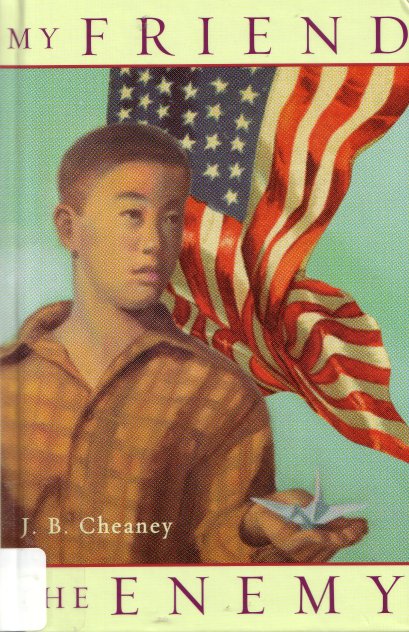
My Friend, the Enemy

This is a young adult book that takes place in Oregon during World War II. Hazel, 11, is one of the main characters along with her older sister Estelle. The other major character, Sogoji, is an orphan Nisei, meaning he is an American citizen born of Japanese parents.
The problem is that this takes place after the Japanese Americans were sent to the internment camps. Sogoji remained behind, which was an illegal act. A white couple is taking care of him.
The book centers around Hazel's initial hatred of Japanese, and then her meeting with Sogoji. Throughout the rest of the book Hazel has to balance her own growing friendship with Sogoji against her anti-Japanese feelings that she has been taught to have by those around her.
There is also a sub-plot about a new schoolteacher who claims to be an American soldier who had been wounded in the war.
Also, the book deals with one of the lesser-known events of the war, and that is the use of the balloon bombs by the Japanese, which were balloons launched from Japan that made their way across the Pacific. The purpose was to act as a terror weapon, starting forest fires and perhaps destroying factories; there was no way of knowing since there was no way of actually controlling where the balloon went.
One of the strongest points of the book is the various references it makes to how people viewed the Japanese Americans on the West Coast. Some of the ways in which the characters in the book refer to them include:
”Sneaky devils.”
”Claude says Japs are sneakier than the Germans.”
”Japs acted tough but were cowards at heart-everybody knew that, not just from the comics but also from posters and movie cartoons. They were small, with buck-teeth and thick eyeglasses. You could tell them from other Orientals because of the space between their big toe and the other toes, caused by the sandals they wore.”
”In newspaper and movie cartoons, Japs had wide, evil grins.”
”Because of you, there's a lot fewer filthy Japs livin' and breathin' on God's green earth...”
”They smile and bow and act so polite, then they turn around and stab you in the back.”
The book also talks about how there was a lot of opposition on the West Coast to the ending of the internment of the Japanese Americans and their returning to their former homes.
Another thing it brings up is how many persons of Japanese ancestry had not learned to speak English (the Issei), and that they are dislike for that; in other words, they refused to fit in to our society, as they argument went.
On the positive side, one of the characters mentions the Japanese Americans who are fighting in Germany on the side of the US (the 442nd group).
The book is an excellent examination of how regular people viewed persons of Japanese ancestry on the West Coast, and just how much prejudice there was against them. The book also tells its story well, with interesting characters. One of the best I've seen on the subject.
Main Index
Japan main page
Japanese-American Internment Camps index page
Japan and World War II index page
|